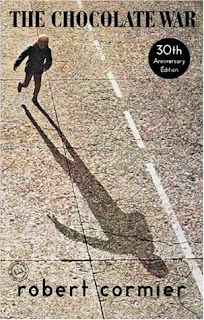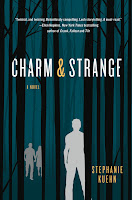For this month’s
interview, I bring to you Chris Tebbetts, author of a number of books,
including the popular MIDDLE SCHOOL series that he co-authors with James
Patterson. In MIDDLE SCHOOL, THE WORST YEARS OF MY LIFE (Little, Brown and Company), readers
meet Rafe, a lonely student who amuses himself by breaking school
rules. MIDDLE SCHOOL, GET ME OUT OF HERE features Rafe struggling to fit in at
a new school. In the most recent book of the series, MIDDLE SCHOOL, HOW I
SURVIVED BULLIES, BROCCOLI, AND SNAKE HILL, Rafe toughs it out through summer
camp.
Bullying is demonstrated
with blunt honesty in the MIDDLE SCHOOL series. In these books, I see bullies
who get away with their behavior. I see frenemies. I see oblivious adults, and
I even see adults who bully children. While these stories acknowledge that the
world does not always play fair, they also show how one can persevere through
rough times.
It’s my pleasure to
bring to you Chris Tebbetts.
How did you get set up
to co-write the MIDDLE SCHOOL series with James Patterson? What kind of a
system do you and James have for collaboration?
Jim found me through
Alloy Entertainment. I’d written a middle grade series for them several years
ago, and when he approached Alloy looking for potential co-authors, mine was
one of the names they gave him. After seeing some sample work from
me, and an interview in New York, he invited me to work with him on MIDDLE
SCHOOL, THE WORST YEARS OF MY LIFE.
As for our process, Jim
will come up with a detailed, chapter-by-chapter outline of the story first.
From there, I'll work on a draft, about ten to fifteen chapters at a
time. Once a month, I send him those pages and we'll talk about how the story
is coming along, as well as any adjustments or changes he wants to make.
Once we get to a finished first draft, I might do some rewriting, but Jim
eventually takes on the whole thing and rewrites it to completion.
And
then on top of that, we have a third collaborator in Laura Park, our
illustrator. She works from the final manuscript and illustration notes
to add all of the art you see in the finished books. The conceit of drawings is that they’re created by our main character, Rafe Khatchadorian, an aspiring artist. That means Laura needs to inhabit the character with her drawings much like we do with the writing, and I think she does it amazingly well. It’s been a blast to see our ideas come to life that way, and to see the humor, details, and spin that Laura brings to the process.
Did Lisa
Papademetriou consult with you when she was working on MIDDLE
SCHOOL: MY BROTHER IS A BIG FAT LIAR?
Lisa Papademetriou and I
didn’t consult with each other on MY BROTHER IS A BIG FAT LIAR. All
of that direct collaboration happened between her and Jim. However—funnily
enough—Lisa and I did co-author a YA novel several years ago (M OR F?,
Razorbill, 2005). The fact that we’re now both working on the MIDDLE
SCHOOL series is just a really fun coincidence—and maybe also a statement about
the small world-ness of the publishing industry.
 What tips do you have
for authors who want to plan and write a successful kidlit series like MIDDLE
SCHOOL?
What tips do you have
for authors who want to plan and write a successful kidlit series like MIDDLE
SCHOOL?
I’m a big fan of
humor—not just as entertainment, but as a way of carrying a story (and its
meaning) to the reader. Humor is something I use for communication
in my life as much as in my writing. Everyone loves to laugh, so you
can’t go wrong there.
A more elemental aspect
of successful middle grade fiction (and fiction in general) is great
characters. That’s the core everything else is built around. I think
it’s well worth taking the time to figure out who your characters are, and then
being extremely picky in the writing process about what feels true for each one
of them. This is as applicable for fantasy as it is for realistic
drama, and everything in between. You have to be willing to grit
your teeth, discard the not-quite-right ideas, and take the time to come up
with something that works better.
Other tips: Don’t write to the
market! By the time you finish a novel based on today’s trend, it
will be yesterday’s trend. Write a story that appeals to you, one
that you feel, and one that you can be excited about going back to
over and over and over again. This is especially true for series
work, where you might be spending years with the same characters. Also, don’t save your
ideas! There will always be more. It can be tempting to
stash away great lines, scenes, or plot twists for later, especially when
you have a whole series to write (and even more especially an open-ended
series). But I’ve never found that kind of scrimping to be worth
it.
 The middle grade voice
and character can be tough to nail, and you and James captured the candid voice
and misunderstood character of Rafe Khatchadorian very well. How did you
develop this character?
The middle grade voice
and character can be tough to nail, and you and James captured the candid voice
and misunderstood character of Rafe Khatchadorian very well. How did you
develop this character?
Rafe came to me from
Jim, who conceived of him and wrote the first, very detailed outline of the
first book (and each subsequent book). A lot of the sense of humor
was in that outline, and I think I lucked out in terms of responding
immediately to what I found there.
For my own part, I did a
good amount of visiting middle schools, interviewing teachers, and most of all,
talking to middle schoolers. One thing that came clear to me through
that process is the way in which the middle school experience has—and more
importantly, hasn’t—changed since I was in sixth, seventh, and eighth
grade. In terms of social and developmental issues, I really heard
back my own experience in those conversations, over and over. That
gave me a sense of permission to draw unreservedly on my own memories, which I
think helped me write more freely than I might have otherwise.
How do you think reading
about Rafe and Georgia’s experiences with bullying can empower young readers
who are bullied?
I like the quote, “We
read to know we’re not alone,” usually attributed to C.S. Lewis.
It feels applicable
here. Everyone who reads these MIDDLE SCHOOL stories is going to relate to the
bullying aspect in one capacity or another—either as someone who has been
bullied, witnessed bullying, perpetrated it, or all of the above. That
kind of mirror can be a powerful thing. It shows readers a
reflection of their own experience without directly implicating them. That,
in turn, can make it all easier to digest and process. From
perspective comes understanding, and from understanding comes positive change.
Let me also say, I don’t
want to over-simplify the issue. For the kids who suffer most from
bullying, it can be overwhelming. It can also feel convincingly
futile—as though there’s nothing to be done for it, and that things will never
change.
But a story that shows a
character coping with his or her own version of those same problems and then
coming out the other side with a sense of hope, accomplishment, or
optimism—that’s a great thing to be able to offer a kid. It’s not a
full solution to a problem as pervasive as this one, but I think it’s an
essential part of the solution.
When you look back on
your own middle school years, what comes to mind? Have you ever been to a
summer camp like Camp Wannamorra?
Okay, here’s where I
part ways with Rafe Khatchadorian. I was a happy kid who mostly
played by the rules, had a lot of friends, and actually liked middle
school. I really lucked out in that regard.
Summer camp, on the
other hand, was another question. I had plenty of bad experiences
there, both as a camper and as a counselor. I just don’t think
summer camp and I were a good match. It always gave me that
alienated feeling, the kind I know is so common for kids in middle school,
where it seemed as though everyone was having a good time but me.
One exception: The
summer after sixth grade, I went to something called night camp, which was
great. We slept during the day and went out at night, scouting
nocturnal critters, working with the raptor center, feeding wounded and
recuperating owls, and learning all about life in the night woods. I
loved it. One of these days, I’m going to write a night camp story.
 Do you have any upcoming
projects you’d like to share about? Will there be any more MIDDLE SCHOOL books?
(Please say yes!)
Do you have any upcoming
projects you’d like to share about? Will there be any more MIDDLE SCHOOL books?
(Please say yes!)
Yes, and yes! Jim
and I are finishing up work on the next MIDDLE SCHOOL book right now. It’s
called SAVE RAFE! and it will be out June 23, 2014.
I also have another
middle grade series out this year, called STRANDED (Puffin), which I co-authored with
Jeff Probst, the host of Survivor. It’s a trilogy about
four siblings who find themselves as castaways on a deserted island in the
middle of the South Pacific. It has lots of adventure, and lots of
nonstop action, which I like to write just as much as humor.
That series was inspired
by the fact that so many young Survivor fans have asked Jeff the same question
over the years: “When are you going to do Survivor for kids?” And
because that’s not a practical idea from a t.v. production standpoint, Jeff
figured this story would be a great way to respond to all that interest. The
first two STRANDED books are already out, and Book 3 comes out this week on November 19th.











































